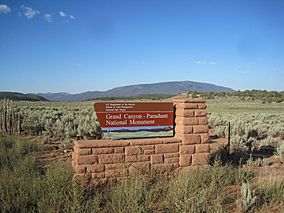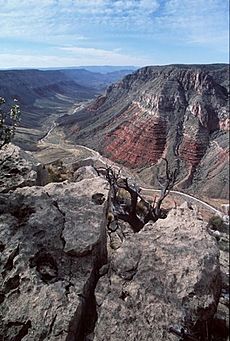Grand Canyon–Parashant National Monument facts for kids
Quick facts for kids Grand Canyon–Parashant National Monument |
|
|---|---|

A sign indicating an entrance to the monument on the Toroweap road
|
|
| Location | Mohave County, Arizona, USA |
| Nearest city | Las Vegas, Nevada |
| Area | 1,048,325 acres (4,242.42 km2) |
| Created | January 11, 2000 |
| Governing body | National Park Service and Bureau of Land Management |
| Website | Grand Canyon–Parashant National Monument |
Grand Canyon–Parashant National Monument (sometimes called Parashant National Monument) is a huge, wild area found on the northern side of the famous Grand Canyon in northwest Arizona. This special place was created by the President on January 11, 2000, to protect its amazing natural beauty and history.
Exploring Grand Canyon–Parashant
This national monument is a very remote and undeveloped place. This means there are no paved roads leading into it and no visitor centers or shops. It's a true wilderness! Two groups work together to manage it: the National Park Service (NPS) and the Bureau of Land Management (BLM).
The monument is incredibly large, covering about 1,048,325 acres. To give you an idea, that's bigger than the entire state of Rhode Island! Most of this land (about 808,747 acres) is managed by the BLM. Another part (about 208,453 acres) used to be part of the Lake Mead National Recreation Area and is now managed by the NPS. There are also smaller sections of state and private lands within the monument's borders. Even though the NPS helps manage it, Grand Canyon–Parashant is not considered a separate national park unit. Its NPS area is counted as part of Lake Mead National Recreation Area.
The land here changes a lot in height. It goes from about 1,230 feet above sea level near Lake Mead to a high point of 8,029 feet at Mount Trumbull. If you want to learn more, you can visit the Interagency Information Center in the BLM Office in St. George, Utah.
The name "Parashant" comes from the Paiute language. It means "tanned elk hide" or "softening of the elk hide." You can also find old ruins of early Mormon settlements in the area, like the Oak Grove Dairy.
Wilderness Areas Inside
Grand Canyon–Parashant National Monument includes several special "wilderness areas." These are places kept as wild as possible, with very few human changes. They include:
- Grand Wash Cliffs Wilderness
- Mount Logan Wilderness
- Mount Trumbull Wilderness
- Paiute Wilderness (part of it)
Amazing Cave Animals
In 2005, a team of scientists explored 24 caves within the monument. They made some exciting discoveries! They found:
- Two brand new species of millipede.
- The first barklouse ever found in North America.
- A whole new group (called a genus) of cricket.
- Four new species of cricket.
These discoveries show how unique and important the caves in Grand Canyon–Parashant are for science!





